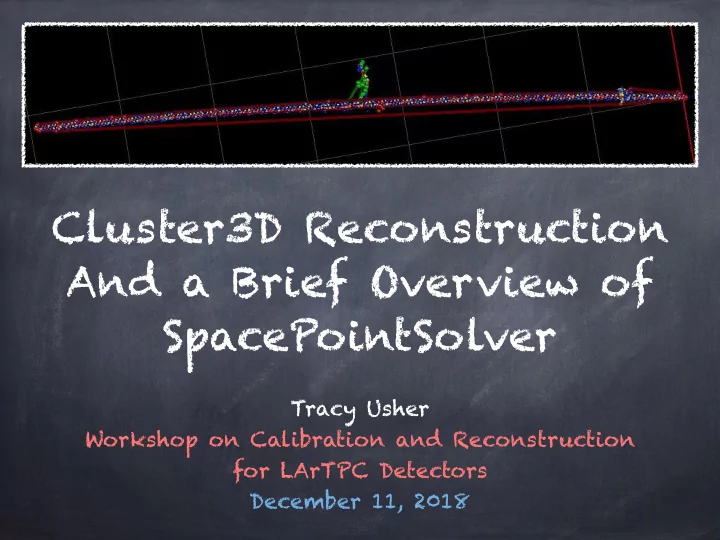

Cluster3D Reconstruction And a Brief Overview of SpacePointSolver Tracy Usher Workshop on Calibration and Reconstruction for LArTPC Detectors December 11, 2018
Overview Motivation 3D Space Point Building “Simple” Cluster3D approach SpacePointSolver Event Slicing Towards Pure 3D Pattern Recognition 2
Motivation Wire readout LArTPC’ s provide exquisite high resolution 2D images of events Stereo images allow for 3D reconstruction Feature finding in 2D which are then matched to get 3D tracks, showers, etc. Use 2D “hit” information to make 3D “space points” and then perform 3D pattern recognition Pros and Cons to both approaches 2D feature finding techniques highly advanced but must deal with many special cases (especially for surface TPCs In 3D the bulk of the special cases disappear and track/shower reconstruction should be “straightforward”… but of course first you need a way to unambiguously build 3D space points Believe 3D approaches ultimately superior and we should work on developing tools to enable them 3
Build Space Points: Simple Approach
Simple Space Points Driving philosophy is that one builds and keeps space points from all “allowed” combinations of individual 2D hits Want high efficiency for “true” space points, willing to accept to accept some level of “fake” space points to achieve goal In fact, one has to accept that there are always ambiguous combinations Assume 3D level algorithms will resolve allowed ambiguities What are “allowed” combinations Hits on different planes, wires must intersect (cross) to make combination 3 2D hits crossing must form the minimum size triangle Hits must agree in time Difference in peak times of 2D hits within range defined by widths The approach is simple, the work is in handling the combinatorics 5
The Obvious Problems Creating space points depends critically on the 2D hit finding efficiency and quality Missing 2D hits will result in either missing space points -or- (worse) the wrong space points Obviously, the 2D hit finding depends critically on the signal processing Building the “correct” space points from 2D hits also requires understanding inter-plane timing offsets 6
The Obvious Pathologies Isochronous tracks Large numbers of 2D hits will agree in time and have good values for the metric above. Generally, once the hits start to have a separation on the order of the average width then the quality metric starts to have value in sorting these out Distorted waveforms Primarily an issue for tracks running along the x axis which create long pulse trains on small number of wires How best to handle these for the purposes of making 3D space points is still an open question 7
Recommend
More recommend